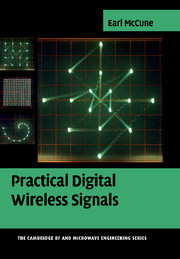Book contents
- Frontmatter
- Contents
- Preface
- Definitions and acronyms
- Terminology and notation
- 1 Keying, states, and block diagram construction
- 2 Common issues and signal characterization
- 3 Important details on results from Shannon, Nyquist, and others
- 4 Digital amplitude modulation (ASK)
- 5 Digital frequency modulation: FSK
- 6 Digital phase modulation: PSK
- 7 Combined digital modulations: QAM and OFDM
- 8 Spread spectrum
- 9 Wireless propagation and antenna fundamentals
- 10 Principles of coding
- 11 Multiple access techniques
- 12 Signal tradeoffs and system evolution
- Tutorial Appendices
- Index
- Frontmatter
- Contents
- Preface
- Definitions and acronyms
- Terminology and notation
- 1 Keying, states, and block diagram construction
- 2 Common issues and signal characterization
- 3 Important details on results from Shannon, Nyquist, and others
- 4 Digital amplitude modulation (ASK)
- 5 Digital frequency modulation: FSK
- 6 Digital phase modulation: PSK
- 7 Combined digital modulations: QAM and OFDM
- 8 Spread spectrum
- 9 Wireless propagation and antenna fundamentals
- 10 Principles of coding
- 11 Multiple access techniques
- 12 Signal tradeoffs and system evolution
- Tutorial Appendices
- Index
Summary
Wireless communications is rapidly becoming one of the ubiquitous technological underpinnings of modern society (such as electric power, fossil fuels, automobiles, etc.). Few people think about the technology within their mobile phones, remote controls, garage door openers, GPS navigation devices, and so on. These devices are always at hand and reliably work for the user.
Yet even within the electrical engineering (EE) community, radio communication techniques have a reputation as a “Black Art” that can only be successfully practiced by “RF people”. This is changing, albeit slowly. Any significant progress in successfully opening this vital technology widely to more practitioners must remove this “Black Art” stigma. In my opinion this is best achieved through outreach from existing successful “RF people”. This outreach must occur through many channels, such as this book and new courses in both academic and industrial training.
Today it takes many years to train communications engineers in the intricacies of wireless signal modulation tradeoffs. I am a product of this decades-long process. Much of this difficulty, for me anyway, is a consequence of the mathematical approach taken to all modulation training. The objective of this book is to begin to add a comprehensive yet physical approach alongside this traditional modulation training.
The contents of this book are drawn from the nearly 40 years of experience I have with radio communication technology.
- Type
- Chapter
- Information
- Practical Digital Wireless Signals , pp. xvii - xixPublisher: Cambridge University PressPrint publication year: 2010



